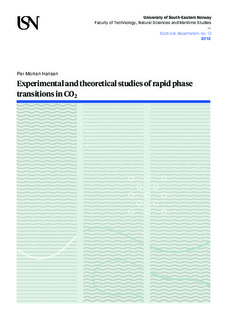Experimental and theoretical studies of rapid phase transitions in CO2
Doctoral thesis
Published version
Permanent lenke
http://hdl.handle.net/11250/2587457Utgivelsesdato
2018-10-19Metadata
Vis full innførselSamlinger
Sammendrag
Rapid depressurization and evaporation of a pressurized liquefied gas are phenomena of relevance to hazard identification and risk analysis in the process industry. Tank explosions and pipeline ruptures are accident scenarios that happen infrequently but have the potential to cause fatalities and significant material damage. This thesis presents results from small-scale experiments and calculations on the rapid depressurization and evaporation of pressurized liquefied carbon dioxide (CO2) in vertical ducts. A motivation was to quantify the damage potential of a sudden CO2 release that originates from scenarios such as a boiling liquid expanding vapor explosion (BLEVE). The primary aim was to describe characteristic velocities and properties behind the evaporation wave as a function of the thermodynamic states ahead of the wave.
The experimental setups in the study included a transparent polycarbonate tube and a rectangular duct. The test sections were filled with pressurized CO2 and sealed with a diaphragm at the upper end. A pulse generator initiated the tests and triggered the diaphragm puncture-device. The instrumentation included pressure sensors, temperature sensors, and high-speed cameras. Upon diaphragm rupture, a rarefaction wave propagated at the local speed of sound into the vapor headspace and further into the liquid phase. Wave reflections occurred at the liquid-vapor interphase and the bottom surface. An evaporation wave followed behind the rarefaction wave. The calculated evaporation wave velocities were in the range 32-42 ms-1. Heterogeneous nucleation occurred at the wall surface ahead of the evaporation wave. Neither the transparent polycarbonate tube nor the square-duct glass-window setup provided a sufficiently smooth surface to suppress nucleation and bubble growth at the surface. The evaporation front details were obscured by the vapor bubbles at the glass window. One test campaign focused on the blast from the CO2 released into an openly vented atmospheric chamber. The measured peak overpressure was in the range 15 – 20 kPa. The initial pre-rupture state was saturated CO2 at room temperature (272 ± 1 K). The rapid boiling did not contribute to the initial shock strength in the test geometry. The evaporation rate was too slow, and the velocity behind the evaporation wave seemed too low to create a shock wave. The heterogeneous wall nucleation seemed to limit the degree of superheat. The tests with a liquid/vapor mixture in the high-pressure reservoir showed a significantly higher impulse compared to the vapor-only tests. Reducing the vent area from 0.1 m2 to 0.01 m2 resulted in a slight increase in the impulse calculated at time t = 100 ms after diaphragm rupture. The experimental results provided reference data that can be used to develop interfacial flux source terms applied in phase transition models. A Rankine-Hugoniot analysis that modeled the phase transition as an evaporation wave calculated the fluid properties behind a CJ wave. Velocities and pressures calculated by model showed good qualitative agreement with the experimental results that were sampled from three separate test setups. The required model inputs were the initial pre-rupture pressure and the pressure of the metastable liquid ahead of the evaporation wave. Typically, the calculated vapor mass fraction behind the evaporation wave was in the range from 0.21 to 0.23. The somewhat limited vapor mass fraction could explain why the rapid evaporation investigations did not produce an observable shock wave. The thesis describe a strategy, which includes the calculated vapor fraction, to predict the mechanical energy released in the rapid depressurization and evaporation processes.
Består av
Paper A: Hansen, P.M., Gaathaug, A.V., Bjerketvedt, D. & Vågsæther, K.: The behavior of pressurized liquefied CO2 in a vertical tube after venting through the top. International Journal of Heat and Mass Transfer 108, (2017), 2011-2020. https://doi.org/10.1016/j.ijheatmasstransfer.2017.01.035Paper B: Hansen, P.M., Gaathaug, A.V., Bjerketvedt, D. & Vågsæther, K.: Blast from pressurized carbon dioxide released into a vented atmospheric chamber. Shock Waves 28(5), (2018), 1053-1064. https://doi.org/10.1007/s00193-018-0819-z
Paper C: Hansen, P.M., Gaathaug, A.V., Bjerketvedt, D. & Vågsæther, K.: Rapid depressurization and phase transition of CO2 in vertical ducts – Small-scale experiments and Rankine-Hugoniot analyses. Submitted to Journal of Hazardous Materials
Paper D: Hansen, P.M., Vågsæther, K., Gaathaug, A.V. & Bjerketvedt, D.: Phase Transition Rate in Rapid Boiling of CO2. Proceedings of the Eighth International Seminar on Fire and Explosion Hazards, Hefei, China, April 25-28, 2016. ISBN 978-7-312-04104-4. https://doi.org/10.20285/c.sklfs.8thISFEH.055
Paper E: Hansen, P.M., Gaathaug, A.V., Bjerketvedt, D. & Vågsæther, K.: Blast from pressurized CO2 released into a vented chamber. Paper presented at the 26th International Colloquium on the Dynamics of Explosions and Reactive Systems, Boston, July 30-August 4, 2017
Paper F: Tøsse, S., Hansen, P.M. & Vågsæther, K.: Modelling and Simulation of Phase Transition in Compressed Liquefied CO2. Proceedings of the 9th EUROSIM Congress on Modelling and Simulation Oulu, Finland, September 12-16, 2016. ISBN 978-1-5090-4119-0. https://doi.org/10.3384/ecp17142653

